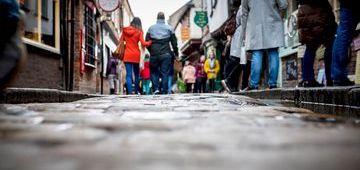- Four in five (80%) of the public would put an end to the school children discounts offered by unhealthy fast food outlets near schools.
- Two thirds (65%) back a ban on new unhealthy fast food outlets within a 5-minute walk of school gates.
- Two thirds also agree (68%) there should be no more junk food advertising across council-owned advertising boards.
A new report outlines a raft of measures aimed at overhauling the after-school street environment for children in the UK. Routing Out Childhood Obesity, a report by RSPH, found that despite wider efforts to support kids’ healthy eating in school and at home, the world they experience between the school gates and the front door can still have a disproportionate effect on diet and lifestyle.
With nine children in every year 6 class overweight or obese, childhood obesity in the UK poses a serious, yet fixable, public health challenge. Backed up by widespread public support, this report identifies four key aspects of the street environment that should be disrupted to give children a healthier route home from school:
Addressing the junk food offer around schools
Including:
- using a mixture of licensing and planning tools to ban unhealthy fast food outlets (FFOs) from within a 5-minute walk of school gates (backed by 65% of the public);
- ending discounts targeted at school children (backed by 80%);
- ending app-based food delivery services to school gates (backed by 80%).
Building better places to go
Including better quality parks with teen use in mind, and physical signage outside schools directing kids to their nearest park.
Transforming active travel
Including a radical upgrade to cycling and walking infrastructure for young people, and scrapping burdensome regulations on lighting for zebra crossings, to allow many more ‘European-style’ crossings to be painted on our streets at low cost.
Limiting the reach of junk food adverts
Including banning the advertising of unhealthy food products across all council-owned advertising sites (backed by 80% of the public).
The full report and recommendations are based on research done in partnership with urban health foundation Guy’s and St Thomas’ Charity, which included mapping the street environments of Lambeth and Southwark to gauge their impact on childhood obesity, and a series of interviews and focus groups with school children from the boroughs.
The full report can be accessed here, and a short film exploring the opinions of school children on the after-school environment can be accessed here.
Shirley Cramer CBE, Chief Executive of the Royal Society for Public Health, said: ‘When the bells ring at the end of the day, a typical school child finds themselves in a situation they would otherwise rarely experience: with time to spare, friends to follow, change in their pocket, no adult direction, and a junk food offer within minutes on foot. It’s small wonder that, in this environment, junk food outlets have become one of the most popular after-school destinations. Our work with Guy’s and St Thomas’ Charity has shown that if we are to give young people in the UK the options they deserve, and not settle for the cheap and unhealthy offer they are currently restricted to, we need a radical revamp of the street environment surrounding our schools.
‘To make this happen, we need to be ambitious and keep in mind the whole picture. As well as keeping unhealthy food outlets away from our school gates, we need to recognise and take action on the influence of ever-present junk food advertising bombarding the public. As well as giving children safe and social areas to spend time after school that aren’t fast food shops, we need to invest in cycling and walking routes to make an active lifestyle the norm and not a chore.’
Kieron Boyle, Chief Executive of Guy’s and St Thomas’ Charity, said: ‘We need to act to improve children’s health in the UK. Right now, the floodgates of unhealthy food options are open wide, and these options are overwhelming children and families.
‘Our joint research with RSPH points to opportunities to transform an important window in the day, when children and teenagers travel home from school. It shows practical ways to expand the flow of healthy, affordable food options and opportunities to run and play. Very few would argue with the idea that the routes children follow from school to home should promote health rather than hinder it.
‘We’re pleased the learning from our work together has inspired RSPH’s calls in this report, and welcome action that helps make the healthy thing to do, the easy thing to do.’



